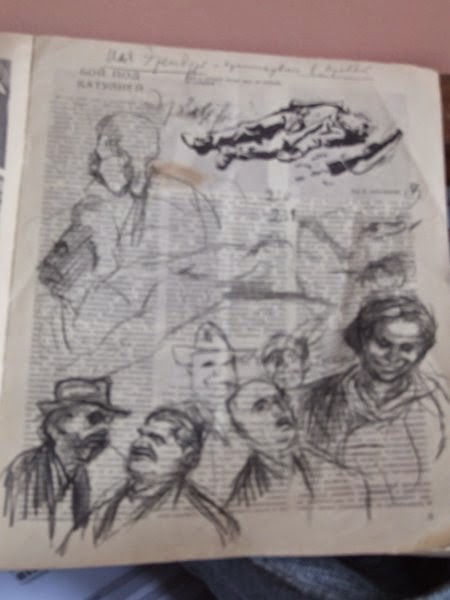I enjoy writing which focuses on objects – WG
Sebald’s use in his novels of old photos; Edmund de Waal’s focus in a family history on amber
miniatures; Neil McGregor’s various histories built on various
cultural artefacts eg Germany – the memories of a nation –
whose entire podacst can be heard here. It’s good also to
see some of the objects – on an excellent blogsite
For
me, this particular approach offers a real window into how people have lived
their lives in the past. My little book on Bulgarian Realist
painters
(subtitled “How to get to know the Bulgarians through their paintings”) lists
140 painters from the early part of the 20th century and tries, in a
few lines, to capture their significance.
This
wasn’t easy – I first have to put the artist’s name in Cyrillic script and then
copy and paste on Bulgarian google – then google translate what seem to be
promising entries. Then there is the problem that these give the barest facts
(except long lists of exhibitions and honours which add not a jot to our
understanding of the person!) And it goes without saying that most art
“criticism” is gobbledygook…
 What
I need is a sense of the character – how they lived their lives…..the friends
they had. I am, for example, very fond of the Gregor Naidenov’s
aquarelles of café life in Sofia in the 1930-1950s – but, so far, have been unable to
find out anything about the man. And I was impressed with a book on Boris Denev
which included lovely black and white photographs of him with friends and in
various studios and exhibitions….also a recent book on a classic Bulgarian
photographer, Stoyan Sertev which not only reproduced many of the old photographs
(including lovely ones of Nicola Tanev) but included a CD of the quartet he
led.
What
I need is a sense of the character – how they lived their lives…..the friends
they had. I am, for example, very fond of the Gregor Naidenov’s
aquarelles of café life in Sofia in the 1930-1950s – but, so far, have been unable to
find out anything about the man. And I was impressed with a book on Boris Denev
which included lovely black and white photographs of him with friends and in
various studios and exhibitions….also a recent book on a classic Bulgarian
photographer, Stoyan Sertev which not only reproduced many of the old photographs
(including lovely ones of Nicola Tanev) but included a CD of the quartet he
led.
I
wrote a couple of weeks ago about the 700 page book I had discovered here based
on Ruhmen Manov’s personal collections of old Bulgarian photos and cultural
artefacts A Fairy Tale about
Bulgaria
which gives a wonderful sense of the history of the country…….
Earlier
in the year my E-book Mapping Romania – notes on
an unfinished journey
used 16 different ways to try to get a handle on the country - namely travel guides; travelogues – which can be divided into the serious or
the (sadly increasing number of) tongue-in-cheek type; histories - which deal with what are considered to be
the key events in the shaping of a nation; novels; social and cultural histories (including jokes) – which
give insights into how ordinary people lived their lives; memoirs and diaries – dealing with those who were more distinguished”; blogs; magazines; television, films and plays; photographs; paintings and caricatures; buildings; conversations and encounters; friendships; music; food and wine
It’s not easy to find books which do justice to countries – travel books do their best but are somewhat one dimensional. More serious books suffer from being written from one particular academic discipline - be it history, economics, politics. Anthropology seems to offer more eg this one I unearthed - The anthropology of Ireland. And this series on the cultural history of cities is quite excellent - which seems to verlap with cities of the imagination (inc Athens, Brussels, Belgrade, Cairo, Dublin, Edinburgh, Istanbul, Lisbon, Madrid, Prague, Seville, Vienna, Zagreb.
Richard Tillingham has a lovely little book - a Traveller's History of Istanbul; and - which is also featured in a great collection "Istanbul; the collected traveler An Inspired Companion Guide" by Barrie Kerper who also offers an instructive blog....
Art critic Robert Hughes' Rome is a real example of how a great writer can transmit knowledge and enthusiasm (he also did a book on Barcelona)
So
perhaps it’s about time that someone gave Bulgaria/Sofia a cultural treatment.
Rumen’s book (which I bought at a discount yesterday – 75 euros) is a useful
start – linked to the book on Stoyan Sertev; to Sofia
Enigma and Stigma which contains eveocative black and white photos of old,
crumbling buildings in Sofia; and to the
marvellous 600 page Sofia’s
Mount Athos which is a superb study (complete with photos and GPS
coordinates) of the 46 monasteries which cluster around Sofia - many since the 14th century. And
Elisabeth Kostova’s The
Historian.
Despite
the continuing political silences about the 42 years Bulgaria spent under
communism, the 20th century can still be felt in Sofia - only this
week I bought a (copy of) a little 1947 litho scene of the part of Vasil Levsky Street which has
the University at the end, complete with one car and a horse and cart – part of
a series dictator Georgi Dmitrov apparently commissioned of artists then. That
was the same day I came across a lovely 1935 landscape by Boris Denev – banned
by the communist regime from paintings after 1944 – which had been lying in a
house for several decades. It still has the typical white frame used in the
1940/1950s.
And
one of my prize possessions is a 1942 journal on every page of which are
several pencilled figures - clearly the work of Ilyia Beshkov, the famous
caricaturist.
